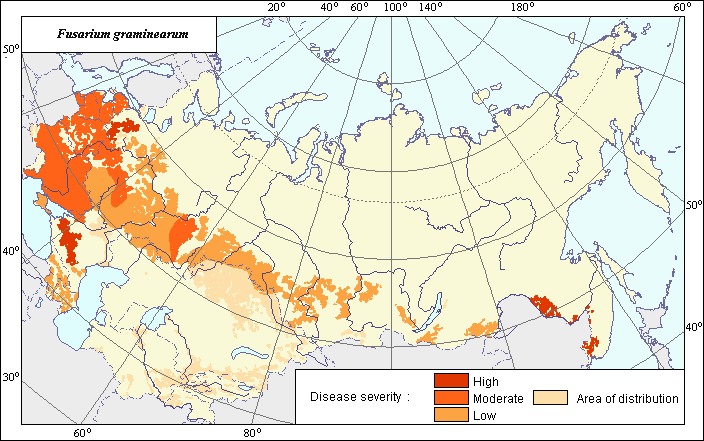Diseases
Distribution and harmfulness of the Fusarium Head Blight (Fusarium spp.) on barley
 Object description Download GIS-layers
Object description Download GIS-layers
Authors:
Specialist-biologist T.Yu. Gagkaeva, GIS-specialist M.I. Saulich.Date of creation:
25.02.2004Scale:
1:20 000 000.Accuracy of map:
Map was created based on materials of maps of natural scale 1:33 000 000Projection:
"Alber.s Equal Area Conic", 9, 1001, 7, 100, 0, 44, 68, 0, 0Basic contents:
Vector map of four thematic layers. Area of species distribution and zones of disease severity are shown by polygons.Accuracy of classifier:All regions represent disease distribution, where the Fusarium Head Blight of barley has been revealed according to scientific publications. Within the area of distribution the area of high harmfulness is where the disease occurs at least 1 time per 2-3 years and the percent of seeds damaged is higher than 5%. The area of moderate harmfulness is where the disease occurs sporadically. The area of low harmfulness is where the Fusarium fungi occurs in a complex of pathogens in barley seeds but has no severe effects on the crop.
Method of map production:
Scientists were given maps with boundaries of Oblasts and arable lands. After reviewing historic literature, species distribution was hand drawn on maps. If data were on the Oblast-level, distribution is on the Oblast level. In some cases, Oblast.s are further refined by boundaries of the Arable Land Map (Koroljeva et al., 2003). Hand drawn maps were scanned, georeferenced and vectorized. The area of the Fusarium Head Blight is widely distributed everywhere in the territory where barley is growing, except the territory of Middle Asia and Kazakhstan, which are too dry for Fusarium disease development (Buga, 1999; Gagkaeva, 2003; Levitin et al., 1994; Piryazeva, 2001; Shipilova, 1994). Regions have been included in the areas of high (the North Caucasus, North-West Russia, and the Far East), moderate (central part of Russia, Ural, Baltic countries, Ukraine, Byelorussia) and low disease harmfulness.Reference citations:
Buga S.F. 1999. Treatments of seeds by fungicides is the first step in protection of cereal crops against diseases. Zashchita zernovykh kul.tur. Minsk. V. 4: 4. (In Russian)Gagkaeva T.Yu. 2003. Importance of Fusarium Head Blight in Russia and the search for new sources of genetic resistance in wheat and barley. In: Canty S.M., Lewis J., Ward R.W., editors. Proceedings of the National Fusarium Head Blight Forum; 2003 Dec 13-15; MN. 219-222 pp.
Levitin M., Ivashchenko V., Shipilova N., Nesterov A.N., Gagkaeva T., Potorochina I.G., Afanasyeva O.B. 1994. Pathogens of Fusarium Head Blight and forms of its appearance in North-western region of Russia. Mikologiya i fitopatologiya, 28(3): 58-64. (In Russian)
Piryazeva E.A. 2001. Sanitary mycological characters of grain forage in Ural and West-Siberian Regions of Russia. Ph.D. Thesis. Moscow. 18 p. (In Russian)
Shipilova N., Gagkaeva T. 1992. Fusarium Head Blight on cereal crops in the North-western region of Russia. Moscow. Zashchita rastenii, 11: 7-8. (In Russian)
Shipilova N.P. 1994. Fusarium species composition and bioecological properties of pathogens of fusariosis on cereals. Ph.D. Thesis. St. Petersburg. 22 p (In Russian)

